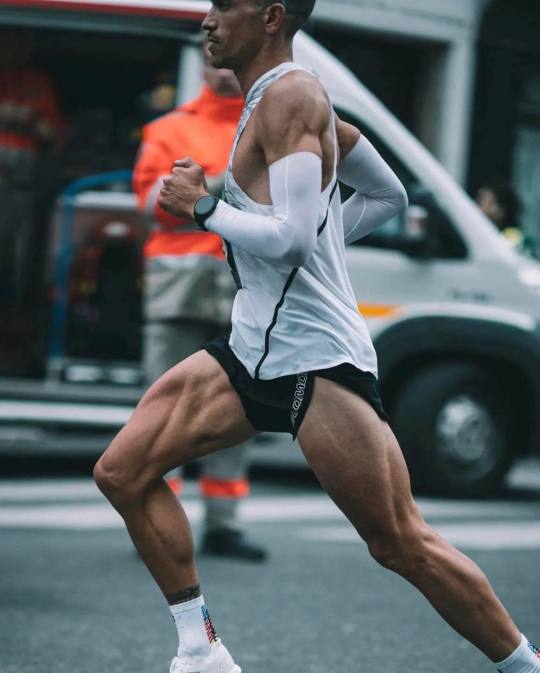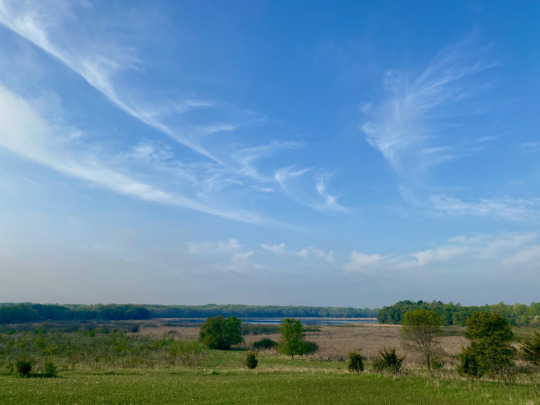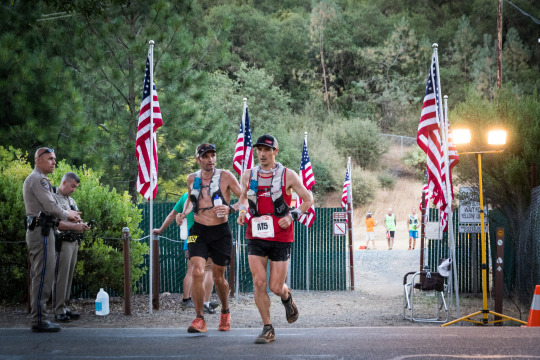#gordy ainsleigh
Text
IL S`ATTAQUE AU MYTHE.
Mathieu Blanchard est au pied d’un monument : la Western States. Des américains qui courent à plus de 10 km/h pendant 160 bornes, une chaleur d’environ 125 degrés et peut-être à la clé la première victoire Française sur la Western. Une chose est sûre : s’il a faim, il pourra toujours croquer dans une de ses cuisses.

Depuis 1974 et le parcours à pieds de Gordy Ainsleigh (avant la course se faisait en canasson), il y a seulement eu 3 vainqueurs non américain : Kilian Jornet (2011), Rob Krar (oui il est Canadien et pas Américain, 2014 et 2015) et Ryan Sandes (2017). Chez les femmes, seulement 4 ont arraché la victoire aux locales : Tracy Garneau (2010), Ellie Greenwood (2011 et 2012), Beth Pascall (2021) et Ruth Croft (2022). On ne dompte pas la Western comme ça.
Ann Trason a remporté 14 fois la Western (10 fois de suite + 4 fois de suite). Scott Jurek 7 fois (et 7 fois de suite). Les records ? 17h10’42’’ pour Beth Pascall et 14h09’28’’ pour Jim Walmsley. Ça va ? Tu veux un gant de toilette humide sur le front ?
Photo Philrouleaufilms
5 notes
·
View notes
Text
Myth #8: Gordy Ainsleigh was the first to cover the Western States Trail Ride on foot during the Western States Trail Ride
Myth #8: Gordy Ainsleigh was the first to cover the Western States Trail Ride on foot during the Western States Trail Ride
https://twitter.com/UltraRunningHis/status/1143217952839196673
View On WordPress
0 notes
Text
A love letter to the sport of trail running: WSER 100 2021
A love letter to the sport of trail running: WSER 100 2021
This weekend was the annual Western States Endurance Run 100 mile trail race, billed as the first 100 mile foot race in North America. What started as a humble brag by Gordy Ainsleigh (his horse went lame for the Tevis Cup, and he decided he could run the 100 mile distance on foot in 24 hours) has grown into the icon of trail running in the United States. Every year the best of the best toe the…

View On WordPress
0 notes
Text
Crewing the 100-Mile Western States Endurance Run
As you read this, I’m hobbling around on stiff legs and a bruised knee from an epic adventure. About a week ago, I stepped off a plane on the other side of the country, nervously excited and full of positive anticipation. I was going to help “crew” and “pace” my friend, Wil, at an event called the Western States Endurance Run.
I am excited to share this you, but, at this point, I just don't have the words or blank space to describe the harrowing detail and tremendous adventure that is an ultra-marathon. Consider this a 10,000 ft. overview. You'll get the idea. Feel free to let your imagination run wild and fill in what it might have looked, felt, smelled and sounded like.
What is Western States? Well, it is a little 100-mile race through the mountains of California. Interestingly, this was initially a horse race, founded in 1955. The original vision was to prove that horses could still cover 100 miles in a day. In 1974, a man named Gordy Ainsleigh was goaded into running, on foot, among the mounted competition. Gordy finished the race in less than 24 hours, proving that humans could cover 100 miles in a day as well. Inspired by Gordy, a foot race eventually formed alongside the horse race as more folks decided to take on the challenge. Today, Western States is the oldest and best known 100-mile Ultra Marathon. Click here for more history and detail.
To give a little perspective, this is the Daytona 500 or Super Bowl of Ultra Marathons. Kind of like those events, it is hard to earn a spot in the race. The race eventually became so popular that they had to limit the number of people who could run in the event. Rather than sign up for the race, like you would a local 5k, hopefuls must apply. Before that application, runners must run a number of qualifying races (generally 2 other 100 mile races in a year) or earn a “golden ticket” by winning a handful of automatic qualifying races. In either case, it is not an easy task. There are also a few spots given to “elite” runners. These are professional runners, if such a term exists. Considering all that, this race has one of the most talent-stacked and seasoned fields of any race. Once you are qualified to enter, the chances of getting in the first time are below 3%. While that is still better odds than the lottery, they really aren’t great.
Wil applied, with the thought that he had worked hard to get a chance to enter one of the most prestigious foot races in the world, but decided not to invest any real hope in the possibility playing out.
Well, he got in.
My main role in all this was to serve as “Crew Chief” for his support crew. This meant I took responsibility for the logistics of getting resources to him during the 24-to-30-hour event. Throughout the race course, aid stations were provided for runners to get water and nutrition. In addition, there were several places where a “support crew” could see their runner. At these stops, we lined out a custom array of food and hydration based on how he felt and how far he had to go to the next one. For this race, we had to split into two crews to be able to get to all the crew aid stations. There was little to no cell phone coverage. This made things interesting.
We also had a very specific supply of first-aid items and a doctor on hand. (Our doctor also served as my driver. Driving through remote mountains was a big responsibility and huge burden at this race. Thank you so much, Bill.) There was a litany of long-run specific ailments we were prepared for. Those include cuts, scrapes, burns, rubs, rashes, blisters, cramps and even stomach ailments.
We also had a stash of extra gear around, just in case. Sometimes he needed new socks, shoes, batteries for his light or other equipment.
Lastly, we tried to give psychological support. That can be tricky. You have to be supportive, reassuring and motivating. Most of the time a runner needs an encouraging word. Sometimes they need a kick in the butt.
Each stop is different, so you have to be ready for anything.
My next responsibility is to serve as a support runner, also known as a pacer. A pacer is someone who runs part of the course with the racer. A pacer is not allowed to carry anything for the racer, but they are there… mostly for moral support. Generally, pacers come on the scene in the second half of the race, when the runner is in a dark place. This is both figurative and literal. For the average ultra-marathoner, the sun has set by the time they get a pacer. At this point the race has thinned from the compressed mob at the starting line to a long, thin broken line. A racer snags a pacer to have someone to run with. The pacer is often part coach, part cheerleader, and part drill sergeant. Sometimes you talk, sometimes you are silent. But you are together.
I was not the only pacer. Lucas was the other one. We were both slated for 16 mile sections, but somehow Luke ended up with an additional 12 miles. He ran those miles fueled by a salad he picked up at a local grocery store. It was an amazing feat.
The hardest part of both crewing and support running is that we’re on the same 24-30 hour time table as the runner. But, rather than running all day, the crew does a lot of watching and waiting. It was a day full of stillness with moments of intense activity.
He finished the race in just over 29 hours. For this, he earned a coveted Western States Belt Buckle and the honor of saying he had finished one of the oldest ultra-marathons on one of the hottest days in its history. 30% of the field was not able to finish the race that day.
So, why talk to you all about this race on our family-themed blog? Good question. I see a handful of ways this can benefit my kids.
1) They get to see and hear of me doing some hard things to support a friend in the accomplishment of his goals. I hope that gives them something to be proud of one day.
2) They get to see that adventure can be found outside our little sphere.
3) They get to hear stories about how people they know pursued their passion, overcame harsh circumstances and did amazing things.
4) They got to see the preparation it takes to accomplish these goals.
5) They get to feel part of the emotions the event creates.
Tell us about a time you helped someone else do something hard?
What have your kids witnessed you prepare for?
0 notes
Text
You're No Spring Chicken
You're No Spring Chicken #trailrunning #riodellago #westernstates
“Your destination is on the right.”
No, its not, Google Maps, there is no destination on my right. Only a field, I think. I can’t see farther than 15 feet outside the car because I’m atop some random California mountain at 11 o’clock on a Saturday night. I forgot my wallet. I’m driving the car of someone I met only an hour ago. I’m from Alabama. I have a slight southern accent. There’s no…
View On WordPress
1 note
·
View note
Text
Ultramarathon Daily News, Thurs, Dec 10
Ultramarathon Daily News, Thurs, Dec 10
No ultramarathon content, but you need to read this: This guy is attempting to break the record for most miles ridden on a bike in a year. Current record is 75k, which means Kurt is on his bike more than half the day, every single day, pushing past 200 miles and 8k calories every single damn day. Holy cow. Caitlin flew sixteen hours for the 50k World Championships and learned some lessons about…
View On WordPress
0 notes
Text
Friday Inspiration: Western States Orginal
The grand daddy of American ultra races, the Western States 100, is this weekend. Irunfar has extensive coverage planned, which I’ll be following religiously. I’d love to see Rob Krar and Alex Varner do well, but its a long race, and there are a lot of talented runners out there. Should be a good race. In honor of Western, here’s a video with Gordy Ainsleigh, the first person to ever run the…
View On WordPress
0 notes
Photo

1 note
·
View note
Video
youtube
Salomon Running TV S03 E06
In 1974 Gordy Ainsleigh competed against the horses in a 100 Mile trail ride through the Sierra Nevada mountains... on foot. In true pioneering spirit he wanted to achieve something that others thought impossible. This single event led to the birth of one of the most famous 100 mile footraces in the world, The Western States 100.
40 years on and Ultra-Distance Trail running has become a global sport complete with professional teams and athletes, yet it has managed to maintain that original pioneering spirit. Every weekend thousands of people toe the line ready to explore their limits, in body and mind.
"The Original" recounts Gordy Ainsleigh's original run and explores of the growth of Ultra-Distance trail running.
0 notes
Text
LE GRAND RETOUR DE LA WESTERN STATES.
À la fin de la semaine, c’est le come-back de l’ultra le plus cinglé de cette fichue planète. Mais pourquoi ? Trois raisons pour te prouver que la Western States Endurance Run est d’une violence digne d’un film de Gaspar Noé.
LA LÉGENDE : un 100 miles qui avant se faisait à cheval est forcement ultra stylé. En 1974, le barbu Gordy Ainsleigh s’est demandé s’il pouvait laisser le canasson à l’écurie et se farcir la distance en courant. Bordel les ricains ils sont quand même au dessus de tout niveau storytelling.
LA CHALEUR : courir la Western States, c’est "ouvrir le four quand un gâteau est en train de cuir et y plonger la tête" selon Thomas Lorblanchet, le Frenchie qui a plus brillé sur cet ultra avec ses baskets qu’avec son accent anglais. La Western, c’est faire un séance de home trainer dans un sauna avec une doudoune pour aller à 8000 mètres. La chaleur est tellement agressive qu’il est moins risqué pour sa peau de se balader en tongs sur les pentes d’un volcan en éruption.
LE NIVEAU : c’est sûr, c’est pas une course à saucisson. Les plus grands coureurs ont gagné le bordel : Tim Twietmeyer, Scott Jurek, Ann Trason, Nikki Kimball, Kilian Jornet, Timothy Olson, Rob Krar… et plus récemment Jim Walmsley alias "la grande tige de Flagstaff" qui a (enfin) atomisé le record l’an dernier.
Bref, cette fin de semaine c’est le grand retour des traversées de rivières, des geysers sur le bitume, des colliers de glaçons, des lignes droites sur l’asphalte avec les 4x4 qui annihilent les poumons des coureurs, des balances aux ravitos, des pacers qui impriment un train d’enfer alors que le coureur est tellement rincé qu’il ne sait même plus quelle lettre vient après "A" dans l’alphabet et de cette arrivée salvatrice sur cette bonne vieille piste d’athlétisme. Que la fête commence.

Photo David Gonthier / Pixel en Cime
2 notes
·
View notes
Video
youtube
Western States 100. 2011 Edition. Kilian Jornet | Salomon Running
10 notes
·
View notes
Text
URP Daily News, Wed, Dec 9
URP Daily News, Wed, Dec 9
Gordy Ainsleigh ran Western for the first time in 1974, starting the “24 hour” craze that’s still going strong 41 years later. Because of that, he has been granted an automatic entry into the race each year since. Unfortunately, he failed to run a qualifying race this year (apparently a requirement in his unique situation), and the WS Board made the decision to not allow him to start in ’16.…
View On WordPress
0 notes